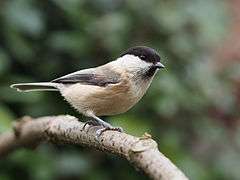Willow tit
| Willow tit | |
|---|---|
 | |
| Scientific classification | |
| Kingdom: | Animalia |
| Phylum: | Chordata |
| Class: | Aves |
| Order: | Passeriformes |
| Family: | Paridae |
| Genus: | Poecile |
| Species: | P. montanus |
| Binomial name | |
| Poecile montanus (Conrad von Baldenstein, 1827) | |
| Synonyms | |
|
Parus montanus | |

The willow tit (Poecile montanus) is a passerine bird in the tit family, Paridae. It is a widespread and common resident breeder throughout temperate and subarctic Europe and northern Asia. It is more of a conifer specialist than the closely related marsh tit, which explains it breeding much further north. It is resident, and most birds do not migrate.
In the east of its range it is much paler than marsh tit, but as one goes west the various races become increasingly similar, so much so that it was not recognised as a breeding bird in Great Britain until the end of the 19th century, despite being widespread.
The willow tit is distinguished from the marsh tit by a sooty brown instead of a glossy blue black cap; the general colour is otherwise similar, though the under parts are more buff and the flanks distinctly more rufous; the pale buff edgings to the secondaries form a light patch on the closed wing. The feathers of the crown and the black bib under the bill are longer, but this is not an easily noticed character. However, the more graduated tail (not square) shows distinctly when spread. Length is 11.5 cm, and wings range from 60–70 mm.
The commonest call is a nasal zee, zee, zee, but the notes of the bird evidently vary considerably. Occasionally a double note, ipsee, ipsee, is repeated four or five times.
The willow tit often excavates its own nesting hole, even piercing hard bark; this is usually in a rotten stump or in a tree, more or less decayed. Most nests examined are cups of felted material, such as fur, hair and wood chips, but feathers are sometimes used. The number of eggs varies from six to nine, with reddish spots or blotches..
Birds feed on insects, caterpillars, and seeds, much like other tits. This species is parasitised by the moorhen flea, Dasypsyllus gallinulae.[2]
Status in UK
According to the RSPB, the willow tit is in rapid decline and is now considered a 'red status' bird. This status was given for two factors:[3]
- BDp¹ - severe, at least 50%, decline in UK breeding population over last 25 years
- BDP² - severe, at least 50%, contraction of UK breeding range over the entire period used for assessments since the first BoCC review starting in 1969
Conservation work is continuing to determine the cause of the willow tit's decline in population and to try to identify ways to improve the situation.[4]
Systematics
Most authorities retain Poecile as a subgenus within the genus Parus, but the American Ornithologists' Union treats it as a distinct genus. This is supported by mtDNA cytochrome b sequence analysis; within Poecile, the willow tit is part of a group of Eurasian "typical chickadees" that includes also the marsh tit, Père David's tit, and the Songar tit
The current genus name, Poecile, is the Ancient Greek name for a now unidentifiable small bird, and the specific montanus is Latin for "of the mountains".[5] The genus name has often been treated as feminine (giving the species name ending montana); however, this was not specified by the original genus author Johann Jakob Kaup, and under the International Code of Zoological Nomenclature the genus name must therefore be treated by default as masculine, giving the name ending montanus.
At one time the willow tit was considered conspecific with the black-capped chickadee of North America due to their very similar appearance. This is seen in an older version of the Peterson Field Guide, Birds of Britain and Europe. Underneath the name it states; "N Am. Black-Capped Chickadee" as an alternate name. In fact the willow tit, black-capped chickadee, marsh tit and Carolina chickadee are all very similar to one another in appearance.
References
| Wikimedia Commons has media related to Parus montanus. |
- ↑ BirdLife International (2012). "Parus montanus". IUCN Red List of Threatened Species. IUCN. 2012: e.T22711703A38464844. doi:10.2305/IUCN.UK.2012-1.RLTS.T22711703A38464844.en. Retrieved 27 August 2016.
- ↑ Rothschild, Miriam; Clay, Theresa (1953). Fleas, Flukes and Cuckoos. A study of bird parasites (PDF). London: Collins. p. 113.
- ↑ Birds of Conservation Concern 3 - 2009, accessed 2012-11-19
- ↑ "Willow Tit". RSPB. Retrieved 2012-05-18.
- ↑ Jobling, James A (2010). The Helm Dictionary of Scientific Bird Names. London: Christopher Helm. pp. 259, 311. ISBN 978-1-4081-2501-4.
